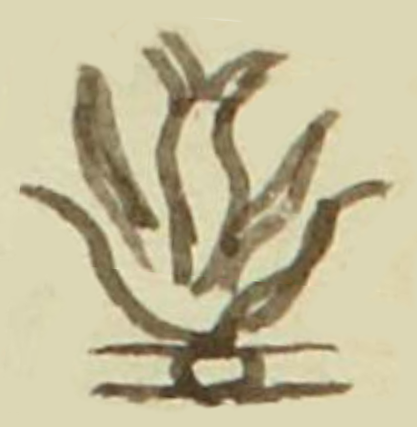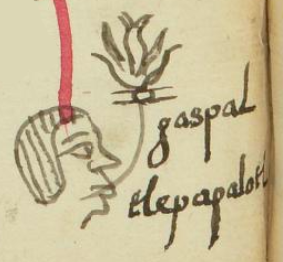Tlepapalotl (MH755v)
This black-line drawing of the compound glyph for the personal name Tlepapalotl (perhaps “Fire-Moth” or “Angry Person”) is attested here as a man’s name. The glyph has two components, one is a fire (tletl) with flames shooting upward. Below the flames is a horizontal object with a circle in the middle. This may be intended to represent a butterfly (papalotl) or moth.
Stephanie Wood
Louise Burkhart (The Slippery Earth, 1989, 207) writes of tlepapalotl as "the moth that flies into the fire and dies" and "was used in indigenous moral discourse to denote the angry person who seeks conflict with others." There is a verb identified by Barry Sell called tlepapalochihua, meaning "to plunge into the fire like a butterfly." The Gran Diccionario Náhuatl gives tlepapalotl as a "butterfly of the night" (my translation of the French from Wimmer 2004). In Seler’s study of the Aubin Tonalamatl, he makes potential associations between the tlepapalotl and tlachinolli. See Eduard Seler, The Tonalamatl of the Aubin Collection, 1901, p. 72; and, in his study of Codex Vaticanus No. 3773 (Codex Vaticanus B), published in 1903, he says that the tlepapalotl "is a synonym of the tlexochtli," p. 29.
Stephanie Wood
gaspal
tlepapalotl
Gaspar Tlepapalotl
Stephanie Wood
1560
Jeff Haskett-Wood
polillas, mariposas, noche, fuego, flamas, nombres de hombres

tle(tl), fire, https://nahuatl.wired-humanities.org/content/tletl
papalo(tl), butterfly, https://nahuatl.wired-humanities.org/content/papalotl
posiblemente, Polilla de Fuego, o Persona Enfadada
Stephanie Wood
Matrícula de Huexotzinco, folio 755v, World Digital Library, https://www.loc.gov/resource/gdcwdl.wdl_15282/?sp=589&st=image
This manuscript is hosted by the Library of Congress and the World Digital Library; used here with the Creative Commons, “Attribution-NonCommercial-ShareAlike 3.0 License” (CC-BY-NC-SAq 3.0).







